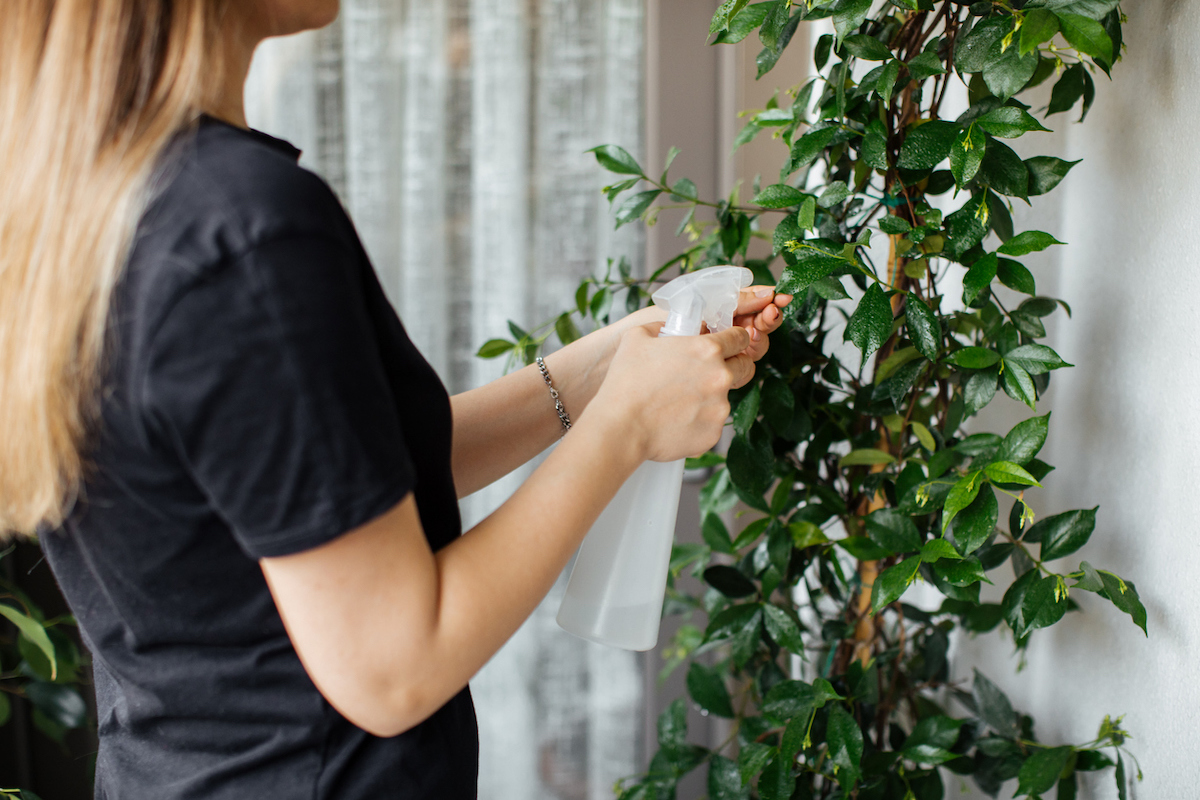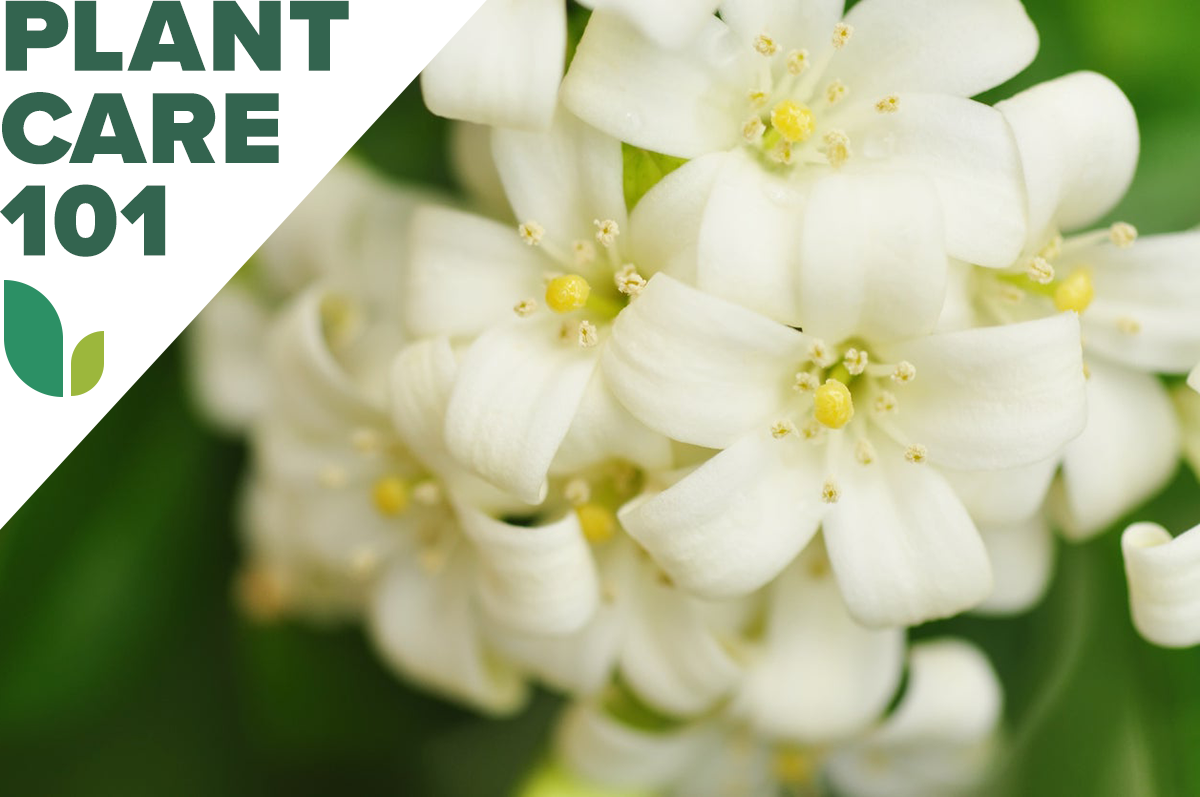We may earn revenue from the products available on this page and participate in affiliate programs. Learn More ›
Not just a Disney princess, jasmine is also one of the world’s favorite fragrances. The white flowers used to scent perfumes and flavor teas generally grow on plants of either Jasminum officinale or Jasminum sambac. However, there are yellow-flowered varieties of jasmine as well as a pink jasmine (Jasminum beesianum).
Jasmine plant care varies according to species and can be challenging for those that require cooler winter temperatures than are usually available indoors. In The Unexpected Houseplant, Tovah Martin recommends Jasminum laurifolium var. laurifolium (aka nitidum) as a good “beginner’s jasmine.”
Indoor Jasmine Plant Care at a Glance
Common Name: Jasmine
Scientific Name: Jasminum spp
Soil: Standard potting mix
Light: Full to partial sun
Water: Moderate
Food: High phosphorus or balanced fertilizer
Temperature and Humidity: Low nighttime temperatures, high humidity
Propagation: Tip or side-shoot cuttings
Safety: Nontoxic
Jasmine Plant Characteristics
The plants differ widely in size, appearance, and hardiness with some bush types remaining as small as the 1-foot J. parkeri and others rising to J. humile’s 12 feet. However, most of those recommended for use as fragrant houseplants are vining white-flowered varieties that top out at some point between 10 and 20 feet. A few, such as J. officinale, can survive as far north as USDA zone 6 while others, such as J. sambac, are hardy only to zone 10. Their foliage tends to be glossy and compound.
Jasmine flowers typically appear star-shaped, with either five or 10 “points.” Some plants called jasmine, such as Brazilian Jasmine (Mandevilla sanderi) and Crepe Jasmine Tree (Tabernaemontana divaricata) aren’t really jasmines at all, so they aren’t covered in this article.

Related: 10 Houseplants You Can Propagate the Fastest for an Ever-Expanding Indoor Garden
Types of Jasmine Plant
- Jasminum laurifolium var. laurifolium (aka nitidum): More tolerant of warm winter conditions than some jasmines, this everblooming Angel Wing Jasmine bears 2-inch white blooms.
- Jasminum officinale: Also known as Summer Jasmine and Common White Jasmine, this type can be hardy to USDA zone 6 and needs chilly winter temperatures to trigger its spring-through-autumn blooms.
- Jasminum polyanthum: This Winter Jasmine probably is the type most often raised indoors since it can grow and bloom in partial sun and produces a virtual flurry of fragrant white flowers during an otherwise drab season.
- Jasminum rex: The Royal Jasmine offers 3-inch white blooms in autumn and winter, the largest flowers of any jasmine—not fragrant but regal enough to make up for their lack of perfume.
- Jasminum sambac: Everblooming and offering more rounded petals than other species, this sweet-scented white variety also goes by Arabian Tea Jasmine or Maid of Orleans and spawned a double-flowered cultivar called Grand Duke of Tuscany.
- Jasminum tortuosum: The Twisted Jasmine produces fragrant white blooms from spring through autumn on a highly vigorous vine.
Selecting Soil for Jasmine Plants
Most jasmines perform well in a standard light and fluffy potting soil. However, a few—such as J. sambac and its cultivars—are prone to root rot, so you may want to increase the aeration in their mix. New York Botanical Garden recommends that you combine one part potting mix with one part peat moss and add one part of builder’s sand or perlite.
Alternatively, you can add a little orchid bark or coir to your potting mix to make it drain faster. Placing your plant in a terra-cotta pot rather than a plastic one will also increase the air around its roots.
The Right Light
Jasmines need at least 4 hours of direct sun per day, which they should be able to receive on an unshaded east-facing or west-facing windowsill. Some, such as J. officinale, prefer even more light and can be placed on a south-facing windowsill instead. They make good bedroom plants since their scent reportedly will help lull you into dreamland.
Keep in mind that J. polyanthum tends to scorch under strong sun, so an east-facing windowsill with its gentle morning rays should work best for this jasmine vine. It also can bloom beneath a fluorescent grow light. If you move your plants outdoors in summer, expose them gradually to the increased brightness and keep sensitive types such as J. polyanthum where they receive morning sun only.
Related: 13 Plants You Can Winter Indoors

Watering Jasmine Plants
During the growing season, from spring through autumn, water your jasmine plant whenever its soil has dried to ½ inch below the surface. In winter, wait a bit longer to water, perhaps until the soil is dry 2 inches down. However, never allow it to dry out completely.
If you choose to grow a type of jasmine prone to root rot, such as J. rex or J. sambac, try to keep it a bit root-bound rather than in an overly large container, which can contribute to sogginess. And always empty the saucer beneath the pot soon after you water the plant, so it won’t be sitting in water for long.
Fertilizing Jasmines
Feed your jasmine every 2 weeks from spring through autumn. Use either a bloom-booster type of plant food such as 15-30-15, in which the middle (phosphorus) number is the highest, or a balanced type in which all the numbers are the same. Refrain from fertilizing the plant during the winter months.
If its leaves begin to yellow between the veins and the problem doesn’t seem to be connected to sogginess or root rot, you may also want to include liquid chelated iron in the feeding regimen to combat chlorosis. Add ½ teaspoon of the iron per quart of water once a month.
Setting the Temperature and Humidity
Jasmines prefer temperatures on the cool side during winter, no higher than 75 degrees Fahrenheit during the day, preferably dropping about 15 degrees at night to 60 degrees or so. During summer, they should be moved outdoors, where they will tolerate temperatures up to 85 degrees.
J. rex and J. polyanthum both need shortening days and cooling temperatures to set blooms. J. polyanthum reportedly will require 6 weeks of conditions between 40 and 60 degrees, so leave both of these types out as late as possible in the fall before bringing them indoors. Since J. officinale needs a chilly winter to bloom for the rest of the year, it should be kept in a 40- to 50-degree greenhouse or sun porch during that season.
Because jasmines prefer fairly high humidity, mist them frequently and place them atop a humidity tray or group them with other plants to raise the air moisture around them.

Related: The Best Plant Subscription Boxes, Tested and Reviewed
Propagating Jasmine Plants
To propagate your jasmine plant, remove 4-inch tip cuttings or side shoots at the beginning of summer, after first sterilizing your pruning shears or knife by cleaning its blade(s) with rubbing alcohol. Cut just below a leaf node each time, or pull off side shoots with your fingers, leaving a small heel of bark from the stem attached to each one.
Remove all but the top couple of leaves on a cutting before dipping its base in rooting powder or liquid. Then place the cutting in a pot of damp and sterile seed-starting mix, deeply enough that the lowest node or the bark heel is covered with the mix. Enclose the pot in a large transparent plastic bag, using sticks or straws to hold the plastic away from the cuttings. Place the pot where it will receive bright, indirect light until the cuttings root, which can take a month or more.
Safety Considerations
As indicated by the fact that it often is added to teas, jasmine is nontoxic to both humans and animals. However, since its fragrance may cause headaches in people sensitive to strong odors, those folks may want to opt for a non-fragrant species such as J. rex or one with a lighter and less intense scent.
Martin calls the scent of J. laurifolium var. laurifolium “more livable than most of its brethren,” meaning that the plant’s “outdoorsy-soapy” fragrance is easier to tolerate than more cloying ones. She also describes the aroma of Jasminum tortuosum as “the sort of scent you can live with happily at close quarters.”
Potential Pests and Diseases
As was previously mentioned, jasmines with poor root systems—such as J. sambac—tend to be vulnerable to root rot. If the foliage on your plant begins to yellow, droop, and die, check the roots to make sure they look firm and light colored. If they appear mushy and dark instead, trim off the rotten parts, repot the plant in faster-draining soil, and reduce the amount you are watering it. You may also want to look for a J. sambac that has been grafted onto the roots of a more vigorous jasmine such as J. tortuosum.
If grown under conditions too warm and not humid enough for them, jasmines can be susceptible to a variety of insects, especially spider mites, which as indicated by paling foliage stippled with tiny dots. Those pests can be controlled with a couple of applications of neem oil spaced a week apart. (Follow the directions on the bottle.)

FAQs
Yes, a jasmine plant should have at least 4 hours of sunlight per day.
Jasmine grows best in an east, west, or south-facing windowsill where it receives direct sun. Low-growing types also can thrive under a grow light.
Some species are naturally everblooming; others require cold treatment to induce buds. (See “Setting the Temperature and Humidity” above.)
Yes. Cut back seasonal bloomers just after they have finished flowering. Prune everblooming types in spring or whenever they grow too large.
Root rot could be the culprit. For the cure, check out “Potential Pests and Diseases” above.
Since a few types, such as J. sambac and J. laurifolium var. laurifolium bloom best as bushes, prune them back a bit whenever they begin to vine to force them to branch out.
Looking for more blooming houseplants? Check out our guides on caring for kalanchoe, goldfish plant, and bird of paradise.


